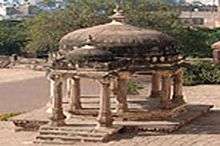Gangadhar Rao
Maharaja Gangadhar Rao Newalkar was the 5th raja of Jhansi situated in northern India, a vassal of Maratha Empire. He was the son of Shiv Rao Bhau and a descendant of Raghunath Hari Newalkar (who was the first governor of Jhansi under Maratha rule).[2]
| Gangadhar Rao | |||||
|---|---|---|---|---|---|
| Jhansi Naresh Maharaja of Jhansi[1] | |||||
 | |||||
| 5th Maharaja of Jhansi | |||||
| Reign | 1838 - 21 November 1853 | ||||
| Predecessor | Raghunath Rao III [2] | ||||
| Successor | Lakshmibai | ||||
| Born | 1797 | ||||
| Died | 21 November 1853 (aged 56 or 57)[3] Jhansi, Jhansi State (present-day Uttar Pradesh, India) | ||||
| Spouse | Ramabai[4] Lakshmibai | ||||
| Issue | Damodar Rao, Ananda Rao[3] | ||||
| |||||
| Dynasty | Newalkar | ||||
| Father | Shiv Rao Bhau[2] | ||||
The ancestors of Gangadhar Rao hailed from Ratnagiri district of Maharashtra. Some of them moved to Khandesh, when Peshwa rule began and served important posts in the Peshwa and Holkar armies. Raghunath Hari Newalkar strengthened Maratha polity in Bundelkhand, however as he grew old, he handed over the reins of Jhansi to his younger brother Shiv Rao Bhau. On the death of Raghunath Rao III in 1838, the British rulers accepted his brother Gangadhar Rao as the Raja of Jhansi in 1843.[6]

He was an able administrator and he improved the financial condition of Jhansi, which had deteriorated during his predecessor’s rule. He took corrective steps to ensure the growth and development of the town of Jhansi. He controlled an army of around 5,000 men. He possessed wisdom, diplomacy, and was a lover of art and culture;[7] even the British were impressed by his statesmanlike qualities. Gangadhar Rao possessed considerable taste and some scholarship; he collected a fine library of Sanskrit manuscripts and enriched the architecture of the town of Jhansi.[8]
In May 1842, Gangadhar Rao married a young girl named Manikarnika, who was renamed as Laxmibai, who later became the Queen of Jhansi and revolted against the British during the uprising of 1857.[3] Raja Gangadhar Rao adopted a child called Anand Rao, the son of his cousin Vasudev Newalkar, who was renamed Damodar Rao, on the day before he died. The adoption was in the presence of the British political officer who was given a letter from the raja requesting that the child should be treated with kindness and that the government of Jhansi should be given to his widow for her lifetime. After the death of the raja in November 1853 because Damodar Rao was adopted, the British East India Company, under Governor-General Lord Dalhousie, applied the Doctrine of Lapse, rejecting Damodar Rao's claim to the throne and annexing the state to its territories.
References
- "Rani of Jhansi". Retrieved 23 August 2015.
- "Rani of Jhansi". Retrieved 23 August 2015.
- "Rani Lakshmibai". Retrieved 23 August 2015.
- Tapti Roy (2006). Raj of the Rani. Penguin Books India. p. 32.
- "Remaking Queen Victoria - Google Books". Books.google.co.in. 2 October 1997. Retrieved 27 September 2018.
- Edwardes Red Year (1975), p. 113
- "Jhansi Ki Rani Laxmibai (English) - Kalpana Ganguly - Google Books". Books.google.co.in. Retrieved 27 September 2018.
- Edwardes, Michael (1975) Red Year. London: Sphere Books; p. 113
Gangadhar Rao Newalkar Dynasty | ||
| Regnal titles | ||
|---|---|---|
| Preceded by Raghunath Rao III |
Maharaja of Jhansi 1838-1853 |
Succeeded by Abolished taken over by British |